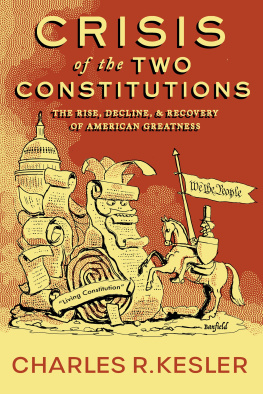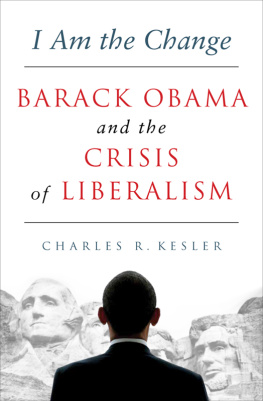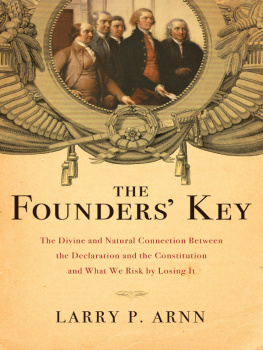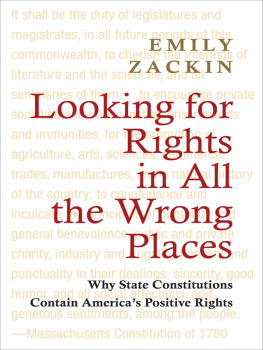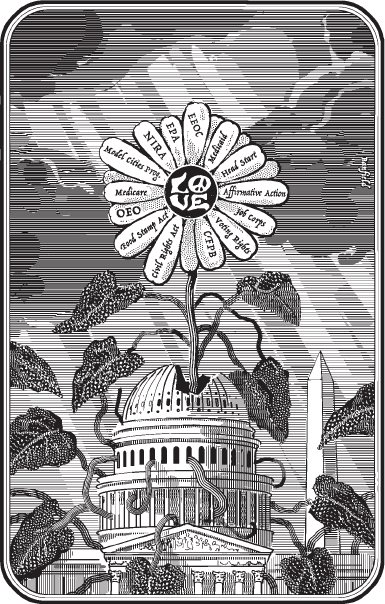
CRISIS OF THE TWO CONSTITUTIONS
CHARLES R. KESLER
CRISIS OF THE TWO CONSTITUTIONS
The Rise, Decline, and Recovery of American Greatness

2021 by Charles R. Kesler
All rights reserved. No part of this publication may be reproduced, stored in a retrieval system, or transmitted, in any form or by any means, electronic, mechanical, photocopying, recording, or otherwise, without the prior written permission of Encounter Books, 900 Broadway, Suite 601, New York, New York 10003.
First American edition published in 2021 by Encounter Books, an activity of Encounter for Culture and Education, Inc.,
a nonprofit, tax-exempt corporation.
Encounter Books website address: www.encounterbooks.com
Frontispiece by Elliott Banfield
Manufactured in the United States and printed on acid-free paper. The paper used in this publication meets the minimum requirements of ANSI/NISO Z39.481992 (R 1997) (Permanence of Paper).
FIRST AMERICAN EDITION
LIBRARY OF CONGRESS CATALOGING-IN-PUBLICATION DATA
Names: Kesler, Charles R., author.
Title: Crisis of the two constitutions : the rise, decline, and recovery of American greatness / Charles R. Kesler.
Description: First American edition. | New York : Encounter Books, 2021. | Includes bibliographical references and index.
Identifiers: LCCN 2020003421 (print) | LCCN 2020003422 (ebook) | ISBN 9781641771023 (cloth) | ISBN 9781641771030 (epub)
Subjects: LCSH: Constitutional historyUnited States. | United StatesPolitics and government. | ConservatismUnited States.
Classification: LCC KF4541.K47 20201 (print) | LCC KF4541 (ebook) | DDC 342.7302/9dc23
LC record available at https://lccn.loc.gov/2020003421
LC ebook record available at https://lccn.loc.gov/2020003422
CONTENTS
To the memory of
Harry V. Jaffa
Peter W. Schramm
Thomas B. Silver
I N NEW YORK CITY on July 9, 1776, after hearing a public reading of the Declaration of Independence, George Washington returned on horseback to his headquarters, leaving a crowd of soldiers and civilians to surge down Broadway to Bowling Green, where a gilt George III sat atop his horse. Some excited young men broke through the iron fence, climbed the marble pedestal, and lassoed the equestrian figure, as Rick Atkinson puts it in The British Are Coming, the first of his three-volume military history of the American Revolution. Down came the massive statue. It was decapitated, stripped of its gold leaf, and shot through several times by musket fire. But the indignities it would suffer had only begun. The head was impaled on a spike outside a nearby tavern. The rest of the king and his horse were soon melted down and molded into 42,088 lead bullets for use by the Continental Army. History does not record if the bullets were marked, Return to Sender.
Toppling a tyrants statue is nothing new. It is a fairly routine part of the heady early days of revolutions across the globe, though it is rarely done with such panache. From the Baltic to the Balkans, for example, as the Soviet empire collapsed around them, statues of Stalin and Lenin disappeared from the public squares of the former captive nations.
But what are we to make of the mobs in America who started pulling down, or otherwise vandalizing, statues? They began with Confederate generals but quickly graduated to George Washington, Thomas Jefferson, Abigail Adams, Ulysses S. Grant, Abraham Lincoln, various abolitionists and Catholic saints, and Saint-Gaudenss great bronze bas-relief monument to the 54th Massachusetts Volunteer Regiment, the storied all-black regiment that fought so nobly in the Civil War. What message are our twenty-first century rebels trying to send? What revolution are they inaugurating?
They protested the horrific death of George Floyd in police custody in Minneapolis, but their broader target was what they called the systemic racism of American police departments, and of America. The New York Times, in its 1619 Project, helpfully provided them a manifesto. At the root of systemic racism, according to the Times, is the original American system of slavery, which began long before but was protected, promoted, and made official in the Declaration of Independence and the Constitution. America was born racist and remains so today. It doesnt get more systemic than racism being in the very DNA of this country, as the Projects originator, Nikole Hannah-Jones, charged.
When I suggested in the New York Post that our civil unrest should be called the 1619 riots, she accepted my criticism as a compliment, replying in a tweet, which soon disappeared from the Web, It would be an honor. Thank you. One has to admire her belated, even if temporary, candor. The New York Times doesnt apparently regard the violence as a mere matter of collateral damage, regrettable but unavoidable. Its more like Americas chickens coming home to roost, as the Rev. Jeremiah Wright, Barack Obamas pastor for twenty years, said of the 9/11 terrorist attacks.
How far we have come from the America whose anti-slavery principles were invoked by the Rev. Martin Luther King, Jr., at the Lincoln Memorial in 1963. He repeated the majestic words of the Declaration of Independence without irony or bitterness, hailing them as a promissory note of American freedom and equality.
If anti-black racism is in our national DNA, however, those promises were hypocritical at best. Still more depressing is the implication of todays woke wisdom that there is very little Americans can do about racism (the new original sin) even if we wanted to. You cant change your DNA. At least you cant make the wholesale change that would be needed to produce a new, non-racist American. Hence the only cure is anti-racism, the never-ending repression of never-ending racism, the proscription of offensive words, sentiments, opinions, and people, which exchanges the old for a new hypocrisy. This is the continuing moral revolution that the progressive Left, in its latest version, is bringing to America.
But it is only the latest version. Two years ago it was the #MeToo movement that seized Brett Kavanaugh, then a Supreme Court nominee, in its coils, insisting on a new, postmodern test of truth: Believe the woman. Her truth, the protestors proclaimed, is stronger than any objective or disinterested truth that might emerge from an adversarial process weighing evidence and testimony. Two years before that, the new revolutionary creed was socialism democratic socialism, as updated by Bernie Sanders, who had no doubt learned a lot about it in his travels to Cuba, Nicaragua, and the Soviet Union. He took that show on the road again this year, and though it got mixed reviews and closed out of town, it managed to write itself into the Democratic Party platform.
One thing we all should have learned, therefore, is that the fall of the Soviet Union did not end the revolutionary challenge to America. Whether the country is guilty of systemic racism, sexism, or capitalism, it is sure as hell guilty of something systemic and evil. The very idea of the System was one of those 1960s slogans (coined by a president of Students for a Democratic Society) that proclaimed its own immoderation, its simplifying antinomianism: whatever the specific vices of the deplorable (American) System it must be overthrown, or at least fundamentally transformed. As Joe Biden declared, I will be an ally of the light, not the darkness.
Next page
